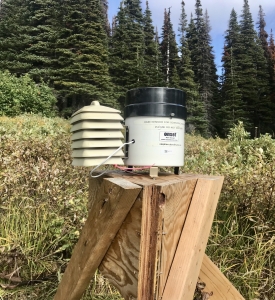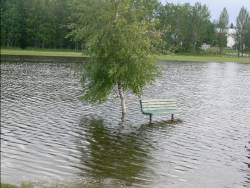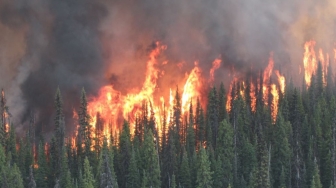Theme 1: Network of Experimental Watersheds for Integrated Research
 In the face of a changing climate, uncertainties are becoming a reality, as seen in extreme weather events globally and in the local Nechako River Basin (NRB). In the past decade, the NRB has faced significant floods, intense forest fires, and prolonged droughts. Looking at the broader Fraser River Basin, which includes the Nechako River, a major concern is the shift in the Fraser River's patterns. It might change from a snow-driven to a rainfall-driven system by the end of this century. This shift carries significant implications, like altered river flows and temperatures affecting salmon spawning and challenges in various sectors like tourism, agriculture, water supply and power generation.
In the face of a changing climate, uncertainties are becoming a reality, as seen in extreme weather events globally and in the local Nechako River Basin (NRB). In the past decade, the NRB has faced significant floods, intense forest fires, and prolonged droughts. Looking at the broader Fraser River Basin, which includes the Nechako River, a major concern is the shift in the Fraser River's patterns. It might change from a snow-driven to a rainfall-driven system by the end of this century. This shift carries significant implications, like altered river flows and temperatures affecting salmon spawning and challenges in various sectors like tourism, agriculture, water supply and power generation.
Our Focus: Unraveling Nature's Patterns
Our research focuses on the connections between climate variables such as air temperature, rain, snow, runoff, streamflow and their impact on water availability in the NRB. Understanding these patterns gives us insights into future changes in water resources in the Nechako watershed and is crucial for developing strategies to adapt to these changes. Our work also extends to understanding extreme weather events and guiding decision-makers in preparing response plans.
Data Collection and Collaboration
Central to our research is a wealth of hydroclimatic data from many sources like Natural Resources Canada, the Pacific Climate Impacts Consortium (PCIC), the European Centre for Medium-Range Weather Forecasts (ECMWF) and our own weather stations. While some data are limited, our collaborative spirit drives us forward. Our network of XX meteorological stations distributed within the NRB stands as proof of our dedication and provides precise measurements of climate variables that serve as climate data.
Understanding and Projecting Nature's Impacts
Our journey began with historical climate analysis from 1950-2010, covering the entire NRB. This foundational work revealed rising air temperatures, declining precipitation, and changes in streamflow patterns. Using advanced models like Air2Stream and Variable Infiltration Capacity (VIC), we have reconstructed historical flows and projected future climate scenarios up to 2100. These projections highlight a significant warming trend, reshaping regional hydrology and stream temperatures. These changes, set to intensify, underline the urgency of our research in the face of nature's evolving patterns. For inquiries about our data sets and collaborative opportunities, please contact Dr. Stephen Dery, the driving force behind our pioneering efforts in understanding meteorological and hydrological changes affecting the well-being of our communities and ecosystems.


